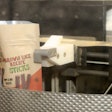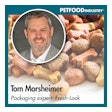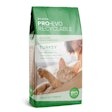
Packaging continues to be a “front line” aspect of pet food, growing increasingly complex in its importance. Pet brands are aiming to be as adaptable as possible, everyone is dealing with the COVID-19 risks inherent in working in a plant setting, and of course the usual innovations in pet food safety and packaging convenience are still requirements for success.
“With COVID-19, we expect further strengthening of rules in general and more specifically on safety and inspection,” said Renaat Van Cauter, director of marketing for Engilico, which deals in sealing inspection and monitoring technology for flexible packages. “Combined with a greater need of automation to reduce manual labor and inspection, we do expect further growing interest in automated inspection solutions.”

Engilico’s seal inspection technology is machine-brand independent, and can be retrofitted to the sealing bars using simple mechanical brackets or bolts without the need to modify the global packaging line layout. | Courtesy Engilico
Automation: covering every aspect of packaging
Everything from the packaging materials used to how the package is sealed play a part in overall pet food safety. According to Engilico, which has seen the number of packaging lines equipped with its seal inspection technology (SealScope) steadily increase, more and more pet food manufacturers are showing interest in inspection technologies that are both reliable and automated — enough so that the company is expanding its capabilities to include seal inspection for rigid packaging, as well.
In fact, automation is a talking point at multiple levels of the packaging process, and for multiple reasons.
“End-of-line automation to reduce the overall cost of packaging pet food will continue to grow in order to remain productive while lowering labor costs to produce,” said Peter Fox, senior vice president of sales for Somic America Inc., which designs and produces end-of-line packaging machines. “This automation effort will ensure the ability to produce consistently high-quality products at a lower cost."

In 2020, Somic will be installing a retail-ready packaging system for a global pet food partner in the U.S. that creates two display trays with high-end graphics and formed aluminum tins standing with the labels facing the consumer. | Courtesy Somic America Inc.
And of course, working in any sort of manufacturing facility has changed in light of the COVID-19 pandemic, though staffing a plant environment has always had its challenges.
“The top challenge is finding labor that is willing to work in a crowded environment like a packaging line,” said Craig Souser, president and CEO of JLS Automation, which focuses on robotic packaging solutions. “Finding people isn’t a new challenge, COVID-19 just made it worse. Manufacturers can and need to overcome this challenge by automating their operations.”

The JLS Osprey is a vision-guided secondary robotic case packing system that automates case packing and manual chub loading processes while ensuring sanitary requirements. | Courtesy JLS Automation
Product diversity = a need for packaging solutions
As demands for different kinds of products increase on the market, the ability for packaging technologies to adapt smoothly is a considerable talking point.
“There is a great deal of talk about ease of changeover as the number of SKUs, meaning flavors and portions, have increased and variety packs have become popular,” said Souser. “We are focused on offering solutions that provide for a minimal changeover time and are highly flexible and adaptable to future changes.”
Finally, the need for visibility in a crowded market continues, and retail-ready packaging is a key part of the flexibility needed to showcase a variety of products.
"I think the biggest need in the pet care business is product visibility,” said Fox. “This is an extremely crowded market and the point of difference is at shelf. Resealable packaging is and will always be important, but making sure that the consumer is able to quickly identify your product on the shelf is paramount.”
Read the companion article, "Sustainability in pet food packaging: An evolving trend,” published in the September 2020 issue of Petfood Industry magazine.

















